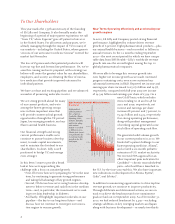Eli Lilly 2010 Annual Report Download - page 7
Download and view the complete annual report
Please find page 7 of the 2010 Eli Lilly annual report below. You can navigate through the pages in the report by either clicking on the pages listed below, or by using the keyword search tool below to find specific information within the annual report.
5
These steps and others are designed to bolster near- and
mid-term revenues and cash flow, and they contribute to
our strategy for YZ.
In a major deal announced in early 2011, Lilly and
Boehringer Ingelheim have entered into a broad world-
wide co-development and co-commercialization agree-
ment in diabetes. This initiative not only promises to
bolster our YZ performance but also plays a key role in
our strategy for re-establishing leadership in diabetes.
Our agreement with Boehringer Ingelheim covers two
late-stage, oral anti-diabetes compounds from Boehringer
Ingelheim: linagliptin, a DPP-4 inhibitor currently under
regulatory review in the U.S., Europe, and Japan; and an
SGLT-2 inhibitor, BI 10773, currently in Phase III clinical
testing.
The agreement also includes two mid-stage basal analog
insulin compounds from Lilly: a novel basal insulin
analog and our new insulin glargine
product. In addition, the agreement
includes an option for the two com-
panies to collaborate on a third Lilly
compound being studied for treat-
ment of complications of diabetes—
a TGF beta monoclonal antibody,
currently in Phase II for chronic
kidney disease.
We believe that the overall value of
these assets will be greater when man-
aged together as a portfolio. We’ll be
able to take advantage of a larger com-
mercial infrastructure, particularly in
primary care, than we could have done
each on our own. This should benefit
Boehringer Ingelheim’s oral products
as well as Lilly’s basal analog insulins,
and may also provide us opportuni-
ties to more effectively promote our
existing injectable diabetes products such as Humalog
and Byetta.
Importantly, this agreement also creates an innovative,
balanced portfolio that may allow us to offer treatment
options to patients and physicians across the progression
of the disease.
Finally, our agreement with Boehringer Ingelheim
provides Lilly with two potential launches during critical
years in our YZ period—linagliptin could come this year
and the SGLT-2 inhibitor in 2014. In both cases, these
assets, if approved, could generate long revenue streams,
with intellectual property protection into the mid- to
late-2020s.
Long Term: Reenergizing the pipeline and reinventing
R&D
Ultimately, the future of our company depends on bring-
ing to patients innovative medicines—both from our
own labs and from outside our walls—and thus driving
long-term growth. Indeed, we’re bullish about the growth
potential represented by the molecules in our develop-
ment pipeline.
As shown in the pipeline on page 7 of this report, we cur-
rently have 68 molecules in clinical-stage development,
and we have seen significant movement in the pipeline
since our last annual report. Specifically, we advanced:
• 17 new molecules into Phase I clinical testing (includ-
ing one currently in Phase II and one that failed),
Lilly’s fundamental
strategy is predicated
on innovation. We must
maintain our focus on
what made this company
great. The science has
never been more promis-
ing, and the need for new
medicines never greater.
• nine molecules into Phase II test-
ing, and
• two molecules into Phase III
testing.
We also acquired five late-stage
molecules. We terminated development
of 15 molecules and sold one molecule
to a third party.
In addition to the molecules in our
diabetes pipeline, which I described
earlier, we advanced new molecules
and indications to Phase III in other
important therapeutic areas:
In neuroscience, we recently began
Phase III trials of NERI as adjunctive
therapy to SSRIs in patients with major
depressive disorder, based on encourag-
ing results from our Phase II studies,
which were presented at medical conferences in late 2010.
In addition, based on an interim review of long-term
safety data and after consultation with the FDA, we made
the decision to begin Phase III trials later this year of our
mGlu2/3 receptor agonist as monotherapy treatment for
schizophrenia.
In oncology, we have had Phase III trials ongoing for some
time for ramucirumab in breast and gastric cancers, and we
recently started trials in liver, colon, and lung cancers. Lilly
and Bristol-Myers Squibb Company have stopped enroll-
ment in a Phase III trial of necitumumab for advanced




















